Camping and outdoor excursions require reliable energy solutions. A lightweight solar panel has become an essential item for outdoor enthusiasts. These panels are easy to transport and contribute to environmental preservation. Modern designs are compact, foldable, and highly efficient, making them ideal for hiking or remote adventures.
The popularity of lightweight solar panels continues to rise each year. In 2023, the market value reached USD 4.36 billion, with projections suggesting it could expand to USD 12.8 billion by 2032. A 100W flexible lightweight solar panel is 70% lighter than traditional rooftop models, making it exceptionally convenient for outdoor activities. Whether used to power devices or provide lighting, these panels are both efficient and portable.
Key Takeaways
- Lightweight solar panels are great for camping. They give portable energy.
- Pick a solar panel with enough power for your needs.
- Choose panels that are simple to carry and fold up.
- Check if the panel works with your devices by matching ports.
- Good solar panels save money and make camping more fun.
Top Picks for 2025
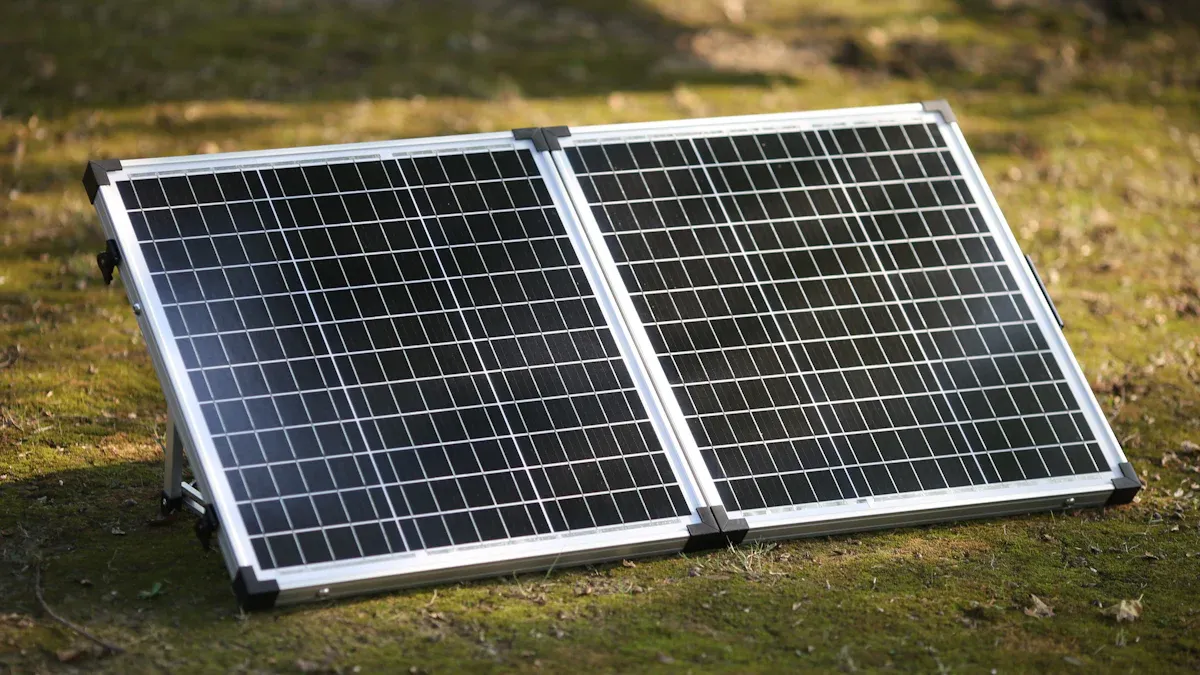
Jackery SolarSaga 100
The Jackery SolarSaga 100 is a top choice for campers. It is light and foldable, making it simple to carry. Its high efficiency ensures steady energy, even in low sunlight. With 100W power and 23-25% efficiency, it works well. Weighing only 4.69 kg, it’s great for those who need portability.
It has USB-A and USB-C outputs, so you can charge devices directly. Made from strong monocrystalline silicon cells, it lasts over 10 years. However, it is water-resistant (IP65) but not fully waterproof. Avoid leaving it in heavy rain for long. Though it costs more, its efficiency and flexibility make it worth the price.
| Feature | SolarSaga 100W |
|---|---|
| Peak Power | 100W |
| Cell Efficiency | 23-25% |
| Weight | 9.1-10.33 lbs (4.69 kg) |
| Folded Dimensions | 24 x 21 x 1.4 in (610 x 535 x 35 mm) |
| Unfolded Dimensions | 48 x 21 x 0.2 in (1220 x 535 x 5 mm) |
| USB-A Output | 5V, 2.4A |
| USB-C Output | 5V, 3A |
| Operating Temperature | 14-149°F (-10-65°C) |
| Warranty | 24 Months |
Tip: Use the SolarSaga 100 with a Jackery power station. This will speed up charging and improve your camping experience.
KickAss 150 + 60W Solar Panel Bundle
The KickAss 150 + 60W Solar Panel Bundle is powerful. It combines a 150W fixed panel with a 60W portable one. Together, they provide 210W of energy, enough for devices or small appliances on long trips.
The panels use efficient monocrystalline cells, working well in bad weather. The 60W panel is light, foldable, and easy to carry. A solar regulator is included for safe energy conversion. While it costs more upfront, its power and flexibility make it a smart buy for serious campers.
Anaconda Mono-Crystalline Solar Panels
Anaconda Mono-Crystalline Solar Panels are tough and efficient. They handle rough outdoor conditions, making them great for camping. With over 21% efficiency, they produce energy even in weak sunlight.
These panels are light and simple to set up. Foldable options make them easier to move. They perform well in heat due to a low-temperature coefficient. Certified to meet global standards, they are built to last. Whether charging gadgets or running a fridge, they are reliable.
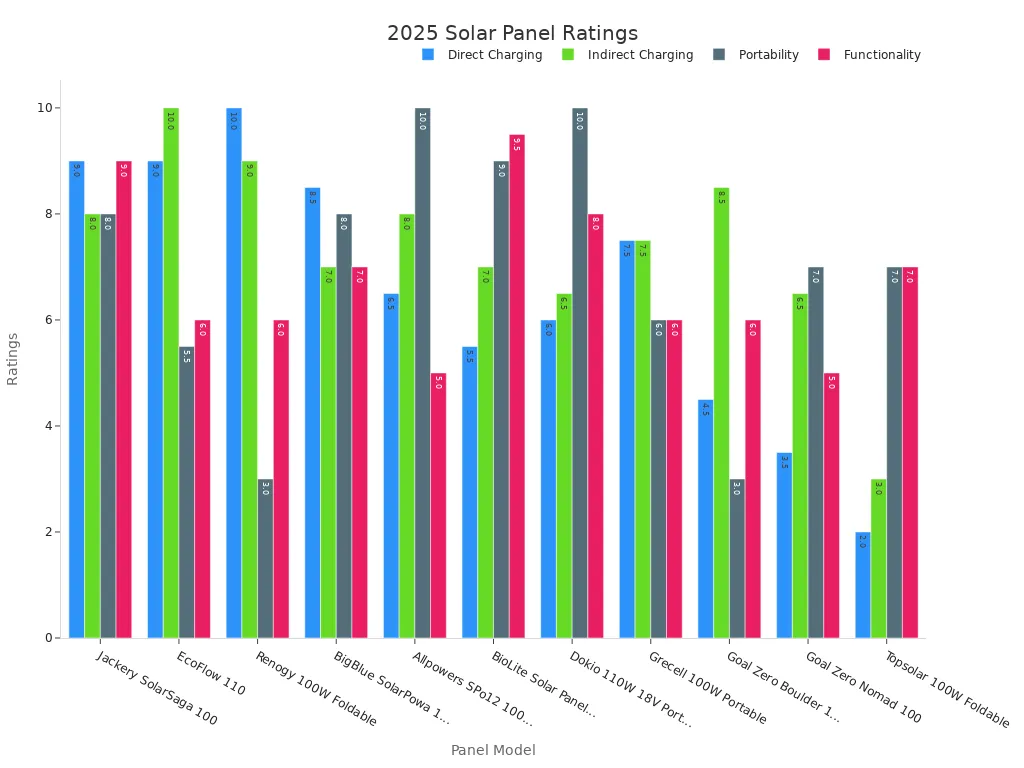
Note: Anaconda panels degrade slowly, keeping their efficiency for many years.
XRSOLAR Lightweight Flexible Panels
The XRSOLAR Lightweight Flexible Panels are unique for their smart design and great performance. They are super thin, only 3-5mm thick, and 500w Flexible Solar Panel weigh 8.4 kg. This makes them one of the easiest panels to carry for camping. You can pack them with your gear without adding much weight. Even though they are light, they provide a strong power output of 500 watts. This is enough to charge many devices or run small appliances during your trips.
These panels work well in extreme temperatures, from -40 °C to 85 °C. This means they can handle both hot summers and cold winters. The XRSOLAR Panels have a high power voltage of 33.76 Vmp and a current of 14.81 Imp. This ensures they produce energy even when sunlight is not perfect. They come with a 10-year warranty for build quality and a 5-year warranty for mobile use. You can count on these panels to last for many camping adventures.
| Feature | Specification |
|---|---|
| Power | 500 watts |
| Maximum Power Voltage | 33.76 Vmp |
| Maximum Power Current | 14.81 Imp |
| Open Circuit Voltage | 36.08 V |
| Short-Circuit Current | 15.65Isc |
| Operating Temperature Range | -40 °C to 85 °C |
| Warranty | 10 years for build, 5 years for mobile applications |
| Weight | 8.4 kg |
| Thickness | 3 mm |
 XRSOLAR Flexible Solar Panel catalog
XRSOLAR Flexible Solar Panel catalog
Tip: Pair the XRSOLAR panels with a solar regulator. This will improve energy conversion and protect your devices.
How to Pick the Best Lightweight Solar Panel
Power and Efficiency
Choosing a solar panel means checking its power and efficiency. Panels with 60W to 400W power are common for camping. A 100W panel is great for small gadgets. A 400W panel can run bigger appliances. Efficiency is also important. Panels with 23% efficiency work well, even in weak sunlight. Monocrystalline panels are often more efficient and save space.
Flexible panels are another good option. They are light and easy to carry. These panels fit curved surfaces like RV roofs. Their design also avoids scratching vehicles. Knowing the benefits of each type helps you choose wisely.
Weight and Ease of Carrying
Weight and portability matter for camping gear. Lighter panels are easier to move and set up. For example, a 120W panel weights 6.7 kg, while a 200W one weights 10.5 kg. Flexible panels are even lighter and foldable, making them perfect for hiking or remote trips.
When comparing, pick panels that are light but strong. Lightweight designs make packing easier and reduce strain. Always check the size and weight to match your needs.
Size and Folding Ability
The size and foldability of a solar panel affect its use. Smaller panels are easier to pack and store. Some flexible panels fold as small as a grapefruit but open wide for energy. This is helpful for campers with little storage space. These panels can also handle 1,000 folds without breaking, lasting a long time.
Creative designs like solar blanket are also useful. They are durable and easy to fold, making them great for outdoor adventures.
Compatibility with Devices
When picking a lightweight solar panel, check if it suits your devices. Not all panels work with every gadget. Look at the output ports carefully. Many panels have USB-A, USB-C, or DC ports. These let you charge phones, tablets, or small appliances. Some panels can directly charge power stations to store energy for later.
Also, check your device’s voltage and wattage needs. For example, a 100W panel cannot run high-power appliances. Match the panel’s output to your device’s input to avoid damage. This ensures safe and efficient charging.
Certification and compliance are also important. Solar tools must meet certain standards to confirm compatibility. These tools measure solar access and create shade reports. A shade report shows details like panel count and solar access percentage. Below is a table of key certification needs:
| Requirement | Description |
|---|---|
| Solar Tool Certification | Tools must measure solar access and create shade reports. |
| Solar Access Calculation | Must include all obstacles and avoid horizon shading defaults. |
| Shade Report Details | Should list PV system info, address, and solar access percentage. |
By checking these factors, you can ensure your panel works well with your devices.
Budget Considerations
Your budget is key when choosing a lightweight solar panel. Prices depend on power, efficiency, and features. Higher wattage or advanced panels cost more but perform better. They may save money over time with improved efficiency.
The solar panel market is growing fast. It could rise from USD 2.5 billion in 2023 to USD 6.7 billion by 2032. This growth shows the rising demand for renewable energy. Better solar technology also drives this trend. Solar panels are a smart choice for eco-friendly campers.
Lightweight panels save money in other ways too. They are easy to install, cutting labour costs. They also reduce structural strain, saving time during setup. Governments support renewable energy to lower carbon emissions. This focus on green energy might make panels cheaper in the future.
Think about both upfront costs and long-term savings. Spending a bit more now could mean better durability and efficiency. This helps you get the best value for your money.
FAQs
How do I take care of a camping solar panel?
Looking after your solar panel helps it work well on trips. Clean the surface often to remove dirt or bird mess. These can block sunlight and lower energy output. Use a soft cloth with water to clean gently. Avoid using strong chemicals, as they might harm the panel.
Check for cracks or loose wires before and after each trip. Store the panel in a case to protect it during travel. If the panel folds, inspect the hinges for wear and tear. Keeping these parts in good shape makes the panel last longer.
Are lightweight solar panels strong enough for outdoor use?
Yes, lightweight panels are made to handle outdoor conditions. Many use special materials to make them tougher. For example, hybrid polymers improve UV protection and efficiency. Research on Perovskite Solar Cells (PSCs) shows they are durable. After 29 weeks outside, these panels still worked at over 16% efficiency. This proves they can perform well in tough environments.
| Feature | Details |
|---|---|
| Type of Solar Panel | Perovskite Solar Cells (PSCs) |
| Key Research Focus | Studying how panels degrade outdoors |
| Efficiency Improvement | Started at 16% efficiency during testing |
| Efficiency After Testing | Stayed above 16% after 29 weeks outdoors |
| Verification | Checked by DOE’s Perovskite PV Accelerator |
| Material Used | Hybrid polymer for better UV protection |
| Publication | Findings published in Science |
Lightweight panels resist water and temperature changes. But don’t leave them in extreme weather for too long. Taking care of them keeps them reliable for your trips.
How long does a camping solar panel last?
Camping solar panels usually last 20 to 30 years. Their efficiency drops slightly over time. Each year, they lose about 0.5% efficiency. By the end of their life, they keep 85% to 88% of their original efficiency. Most manufacturers offer warranties for this period, giving you good value.
- Solar panels last about 20 to 30 years.
- Efficiency drops by 12% to 15% over their lifespan, losing about 0.5% per year.
To make your solar panel last longer, follow the care tips above. Regular cleaning and safe storage will keep it working well for many years.
Can I use a lightweight solar panel in cloudy weather?
Yes, you can use a lightweight solar panel on cloudy days. However, its performance will not be as strong. Solar panels need sunlight to make electricity. When sunlight is less, like on cloudy days, they work less efficiently. Modern panels, especially monocrystalline ones, are better in low light than older types.
Monocrystalline panels can reach 22%-24.5% efficiency in cloudy weather. Thin-film panels only manage 10-12%. This makes monocrystalline panels a smarter choice for camping in changing weather. The energy a panel produces depends on solar irradiance. This measures sunlight strength in watts per square metre (W/m²). On cloudy days, lower irradiance means less energy is made.
| Metric | Description |
|---|---|
| Efficiency of solar panels | Monocrystalline panels work better (22-24.5%) than thin-film ones (10-12%) in low light. |
| Impact of solar irradiance | Energy output depends on sunlight strength measured in W/m². |
| Testing conditions | Panels are tested under Standard Test Conditions (STC) with 1,000 W/m² of sunlight. |
Tip: To get more energy on cloudy days, tilt your panel to catch the most light. Keeping it clean also helps.
How do I know if a solar panel is compatible with my devices?
To check compatibility, compare the panel’s output with your device’s needs. Most lightweight solar panels have USB-A, USB-C, or DC ports. These work with phones, tablets, and cameras. Look at the voltage and wattage of both the panel and your device. For example, a 100W panel can charge small gadgets but not large appliances.
Some panels have built-in regulators to control voltage and protect devices. If your panel does not have one, use an external solar regulator. This keeps energy stable and prevents damage to your gadgets.
Note: Always read the manufacturer’s details for both the panel and your devices. This avoids problems and ensures safe charging.
By knowing these details, you can pick a solar panel that fits your camping needs.
Picking the right solar panel can improve your camping trips. The best choices for 2025, like the XRSOLAR AIO-100W and Sunman Lightweight Flexible Panels, give great power and are easy to carry. When choosing, check how efficient the panel is, how much it weighs, and if it works with your devices. The way you position the panel and sunlight strength affect how much energy it makes. If you move your gear often, a portable panel is very useful. Cheaper options can still give good value for your money. A good solar panel makes camping eco-friendly and stress-free.
FAQ
How should I store a lightweight solar panel?
Keep your solar panel in a dry, cool spot. Use a case to protect it from scratches or damage. Don’t place heavy things on top of it. If it folds, clean the hinges before storing to avoid dirt build-up.
Can lightweight solar panels charge power banks?
Yes, they can charge power banks easily. Check if the panel has USB-A or USB-C ports. Make sure the panel’s voltage and wattage match your power bank’s needs. A solar regulator helps keep charging safe and steady.
What if my solar panel gets wet?
Most lightweight solar panels can handle light rain but not heavy water exposure. Dry the panel quickly if it gets wet. Always check the manufacturer’s water resistance details to know its limits.
Do lightweight solar panels work during winter?
Yes, they work in winter if there’s sunlight. Cold weather can make them more efficient, but shorter days might lower energy output. Remove snow and keep the panel clean to get the most sunlight.
Are flexible solar panels as strong as rigid ones?
Flexible panels are strong but not as tough as rigid ones. They can handle small impacts and bending but wear out faster in harsh conditions. Avoid bending them too much to make them last longer.
Tip: Follow the care instructions from the manufacturer to keep your panel in good shape.

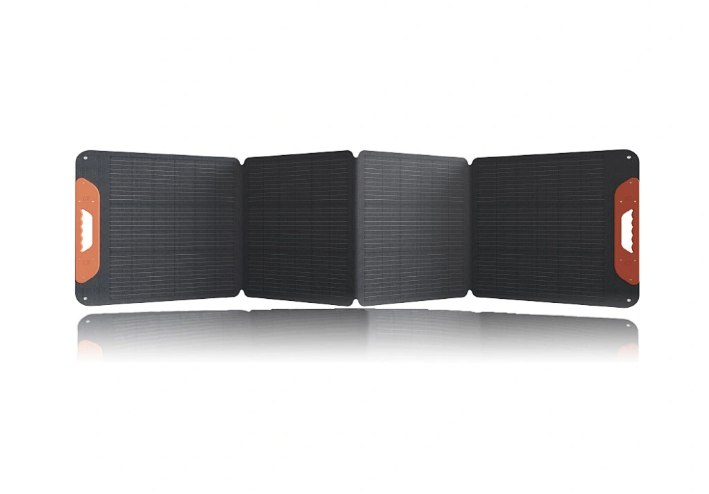
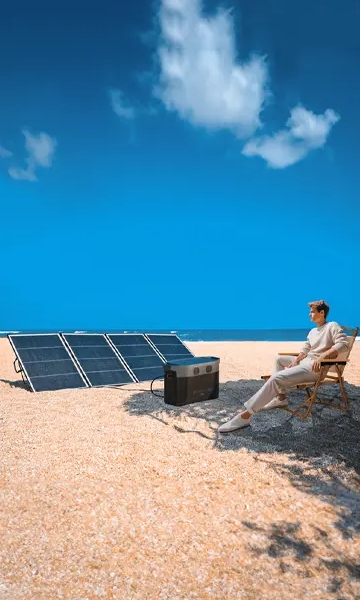
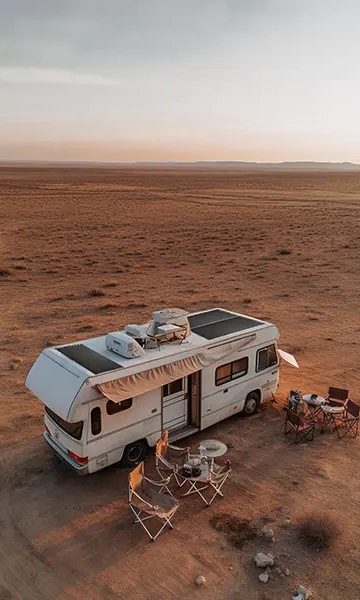
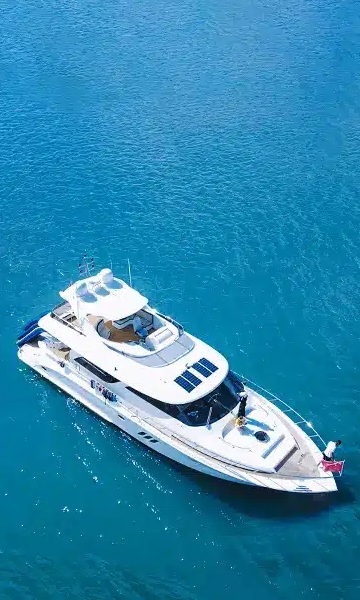
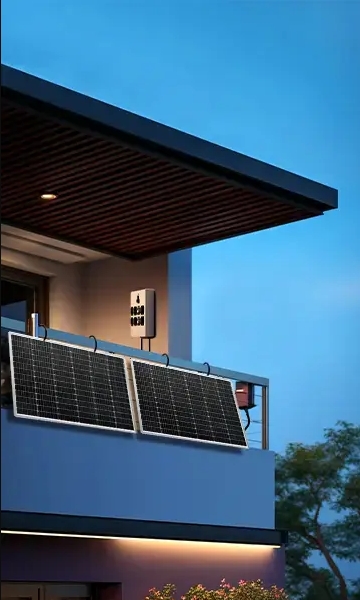
0 Comments